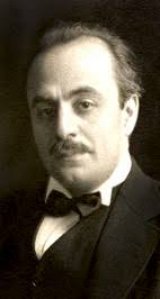Analysis of On Good and Evil
Kahlil Gibran 1883 (Bsharri, Mount Lebanon Mutasarrifate) – 1931 ( New York City)
And one of the elders of the city said, Speak to us of Good and Evil.
And he answered:
Of the good in you I can speak, but not of the evil.
For what is evil but good tortured by its own hunger and thirst?
Verily when good is hungry it seeks food even in dark caves, and when it thirsts it drinks even of dead waters.
You are good when you are one with yourself.
Yet when you are not one with yourself you are not evil.
For a divided house is not a den of thieves; it is only a divided house.
And a ship without rudder may wander aimlessly among perilous isles yet sink not to the bottom.
You are good when you strive to give of yourself.
Yet you are not evil when you seek gain for yourself.
For when you strive for gain you are but a root that clings to the earth and sucks at her breast.
Surely the fruit cannot say to the root, “Be like me, ripe and full and ever giving of your abundance.”
For to the fruit giving is a need, as receiving is a need to the root.
You are good when you are fully awake in your speech,
Yet you are not evil when you sleep while your tongue staggers without purpose.
And even stumbling speech may strengthen a weak tongue.
You are good when you walk to your goal firmly and with bold steps.
Yet you are not evil when you go thither limping.
Even those who limp go not backward.
But you who are strong and swift, see that you do not limp before the lame, deeming it kindness.
You are good in countless ways, and you are not evil when you are not good,
You are only loitering and sluggard.
Pity that the stags cannot teach swiftness to the turtles.
In your longing for your giant self lies your goodness: and that longing is in all of you.
But in some of you that longing is a torrent rushing with might to the sea, carrying the secrets of the hillsides and the songs of the forest.
And in others it is a flat stream that loses itself in angles and bends and lingers before it reaches the shore.
But let not him who longs much say to him who longs little, “Wherefore are you slow and halting?”
For the truly good ask not the naked, “Where is your garment?” nor the houseless, “What has befallen your house?”
| Scheme | ABAXX CADX CCXXX XEX XFBE XBX XXXFD |
|---|---|
| Poetic Form | |
| Metre | 0110101010111111010 0110 10101111111010 1111011101111001 11111011110011011111101110 1111111101 11111110111110 100101110111111000101 00101101101000110011111010 11111111101 1111101111101 111111111011110101101 10011011011111010101011010 1101101011010101101 1111111001011 111110111111100110 0101001110011 111111111100111 111110111110 101111110 111110111111101011110 111010101111011111 111010001 10101101101010 0110111011110011010111 10111110101010111011000101010011010 00101101111001010010100111001 111111111111101111010 1010111010111101011101011 |
| Characters | 2,267 |
| Words | 426 |
| Sentences | 28 |
| Stanzas | 7 |
| Stanza Lengths | 5, 4, 5, 3, 4, 3, 5 |
| Lines Amount | 29 |
| Letters per line (avg) | 57 |
| Words per line (avg) | 15 |
| Letters per stanza (avg) | 238 |
| Words per stanza (avg) | 60 |
Font size:
Citation
Use the citation below to add this poem analysis to your bibliography:
Style:MLAChicagoAPA
"On Good and Evil" Poetry.com. STANDS4 LLC, 2024. Web. 19 Apr. 2024. <https://www.poetry.com/poem-analysis/54016/on-good-and-evil>.


Discuss this Kahlil Gibran poem analysis with the community:
Report Comment
We're doing our best to make sure our content is useful, accurate and safe.
If by any chance you spot an inappropriate comment while navigating through our website please use this form to let us know, and we'll take care of it shortly.
Attachment
You need to be logged in to favorite.
Log In